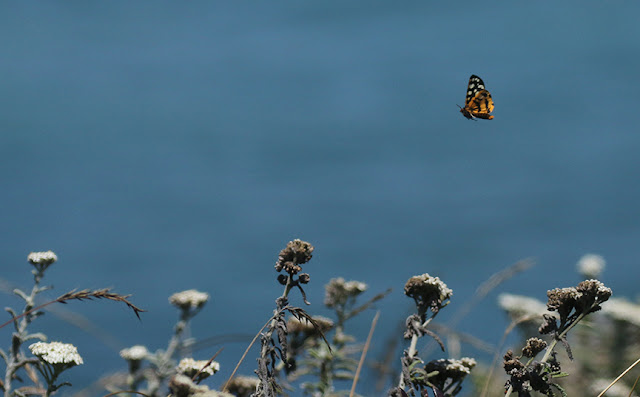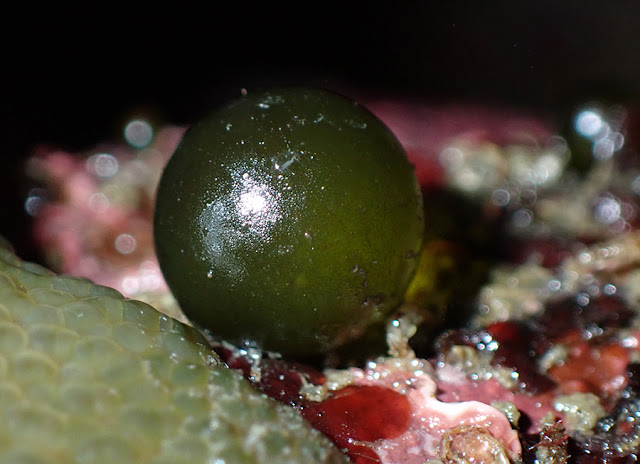Lots of Ranchman's Tiger Moths (Platyprepia virginalis) out and about today (30 June 2022).
Thursday, June 30, 2022
Wednesday, June 29, 2022
Sunday, June 26, 2022
Acorns in Sonoma County
During the past 6 months, Eric and I have occasionally observed a bright orange animal among stones/gravel in the intertidal zone. At first we thought it might be a ribbon worm, but something didn't seem quite right. Eventually we figured out that we were seeing our first acorn worm in Sonoma County. Meet Saccoglossus pusillus!
Acorn worms are probably unfamiliar to many people — including me! They're in the phylum Hemichordata and are really different from other animals you might encounter in local tidepools.
Here's a basic illustration of their body plan. They're worm-like (vermiform), but note the three major body sections — the proboscis, the collar, and the trunk:
In the first photo (above), you're seeing the long, highly extensible proboscis. Before seeing these individuals, I hadn't realized how far the proboscis could stretch.
Behind the proboscis is the much shorter collar. The acorn worm's mouth is hidden inside the collar. In this species, the collar is darker in color, so somewhat reddish. In the next two photos, you can see just a hint of the collar where the proboscis meets the substrate. [Acorn worms live in burrows below the surface, so the trunk isn't visible in these photos...but see the video clip at the bottom of this post.]
P.P.S. Many thanks to Eric for an excellent video clip!
Saturday, June 25, 2022
3 for 3,000
Whew, well it's hard to believe, but this is post #3000! (3000 posts over 10.5 years.) So here's a little video clip to mark the occasion.
This is an older video (from 2018), but I've wanted to share it for a while. It shows a River Otter family (a mother and three pups) on a morning outing — waking up from a nap, using a communal latrine, sliding down some Feather Boa kelp into the water, swimming along the shoreline together. And it includes audio! I've written about otter calls before — the pups use a high-pitched bird-like chirp to keep in touch with the rest of the family.
On this day I was working quietly in the low intertidal zone when I noticed this otter family swimming by. They swam past me, climbed up onto the seaweed-covered rocks, and curled up for a nap! I didn't want to disturb them, so I kept working and watched for activity out of the corner of my eye. Eventually they woke up and that's when this video clip starts.
I didn't know the otters were going to make their way back towards where I was working. You'll see that eventually they notice me. One of the pups makes sure the others know about me, too, and then they continue along the shoreline.
I hope you enjoy this little window into the life of River Otters. Thanks so much for checking into the Natural History of Bodega Head blog. Knowing you're out there inspires me to keep learning and to keep sharing. Who knows how far beyond #3000 we'll go!
Friday, June 24, 2022
Garden of orbs
I don't see this algae very often, but encountered a couple of nice patches recently.
Meet Derbesia marina, sometimes referred to as Green Sea Grape.
Wednesday, June 22, 2022
So egg-citing!
So cool! This is a female Ochre Sea Star (Pisaster ochraceus) spawning.
We had to work a little late tonight, but it paid off because just before we were getting ready to leave, Eric noticed that a few sea stars were spawning in one of the tanks at the lab!
It's possible they were triggered by the recent change in the weather. When the NW winds are strong, seawater temperatures are usually cool; then when the winds calm down, seawater temperatures often rise. Yesterday the seawater temperature was 9°C (48°F), but it increased to 13°C (55°F) today.
Here's an even closer view where you can see a large number of eggs being released through pores in the surface of the sea star:
Tuesday, June 21, 2022
Rocks in the pools?
Last week we encountered a few juvenile rockfish at different sites along the Sonoma Coast. Here are a couple of examples. Both fish were ~2 inches (~5 cm) long. I'm not sure which species of rockfish these are, so any comments/suggestions are welcome.
Monday, June 20, 2022
Why so rusty?
Sunday, June 19, 2022
Two cukes
I think we've seen 10 species of sea cucumber in the Sonoma/Marin county area, and over the years I've posted photos of 8 of those, but I haven't shown pictures of a couple of species yet.
So here are two more — above is the Orange Sea Cucumber (Cucumaria miniata). As you can see, they often live under rocks or in crevices, but sometimes you can catch a glimpse of their bright orange tentacles.
Below is a California Sea Cucumber (Apostichopus californicus, formerly Parastichopus californicus). This species is more common in subtidal areas, but with the very low tides last week, I spotted one in the low intertidal zone:
Saturday, June 18, 2022
Reaching
Friday, June 17, 2022
Rainbow sculpin?
An amazing sculpin resting on a pale purple sponge. Photographed in the low intertidal zone on 17 June 2022.
Thursday, June 16, 2022
Tuesday, June 14, 2022
Morning adventure
Got lucky and noticed a River Otter ahead of us after field work this morning. I don't always bring a larger lens with me when we're doing intertidal work, but I had one today. Such a wonderful portrait! I love how the brown color of the otter's fur matches the seaweed (Endocladia muricata) so well.
Sunday, June 12, 2022
An assortment
Above, a glowing paintbrush, possibly Mendocino Coast Paintbrush (Castilleja mendocinensis)?
I have a backlog of photos from field work in late May/early June from northern Sonoma County and southern Mendocino County. Here are a few more!
Coast Onion (Allium dichlamydeum) along the bluff edge:
Thursday, June 9, 2022
Blue and copper
About a week ago we were walking back from field work and noticed a few brilliant Blue Coppers (Lycaena heteronea) nectaring on buckwheat flowers (Eriogonum sp.).
Males are bright blue above:
Wednesday, June 8, 2022
Ocean views
Happy World Oceans Day!
Above, view looking south along the Sonoma Coast.
Below, a sculpin photographed recently in a tidepool near Point Arena.
Monday, June 6, 2022
In a wilderness of stones
On our way out to a field site recently we came across a Black Oystercatcher (Haematopus bachmani) nest. We moved on so as not to disturb the birds, but I took a quick photo with my telephoto lens. It is such a beautifully constructed nest! Hundreds of rock chips gathered to produce a shallow bowl.
Later I was reading a short story by A.S. Byatt and was struck by the phrase "in a wilderness of stones." She was writing about "moor birds" (perhaps grouse in Great Britain?), but my mind went immediately to this oystercatcher nest. Looking at the photo we were struck by the number of stones used to make this nest, and the phrasing seemed just right, describing both the eggs surrounded by stones as well as the world of Black Oystercatchers.
With thanks to A.S. Byatt, the oystercatchers, and the stones, and the elements that shape them.
Sunday, June 5, 2022
Tropical visitor
A rare sighting of a Nazca Booby (Sula granti) in Bodega Harbor today (5 June 2022). Many thanks to Peter Colasanti for spotting the bird and to Rick LeBaudour for sharing two excellent photos (above and below).
Nazca Boobies are resident in the Eastern Tropical Pacific — primarily breeding on the Galapagos Islands, Malpelo Island off Colombia, as well as smaller islands from Peru to Mexico. They're rare in Northern California and this is the first record for Sonoma County.
This individual spent time throughout Bodega Harbor today, ranging from the north end near Mason's Marina and Porto Bodega and along the boat channel to the Coast Guard Station. Not sure if it will be around tomorrow, but it would be worth a look!
It was a little distant for my camera/lens, but here are a few more shots. Look for the orange bill and the white feathers in the center of the tail (from above, see last photo). These features help distinguish it from Masked Booby (Sula dactylatra).
Saturday, June 4, 2022
Offshore account?
A quick shot of an impressive offshore fog bank yesterday. Photographed south of Fort Ross on 3 June 2022.
Wednesday, June 1, 2022
Rooms with a view
After field work this morning, I was hearing some Cliff Swallows (Petrochelidon pyrrhonota) calling and was wondering where the swallows were. In trying to locate the birds, I was puzzled at first the my ears were leading me to an offshore sea stack. But then a few birds appeared and swooped up into a groove in the rock! I'm probably not in the right places often enough to see this, but I couldn't recall observing them nesting on a sea stack before. Looking more closely, I eventually found a few nests.
Above is a view of the sea stack. The nests are in two locations — next to the jagged notch (cut-out) at the upper right corner of the rock, and along the dark groove that curves down vertically at the lower right corner of the rock. Below is a closer view where you can look for the rounded mud nests attached to the rock:
















































